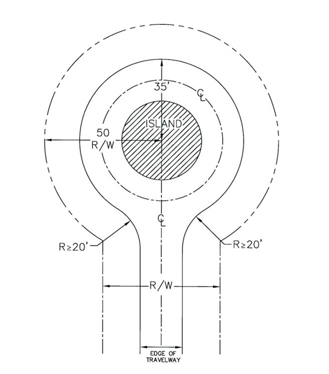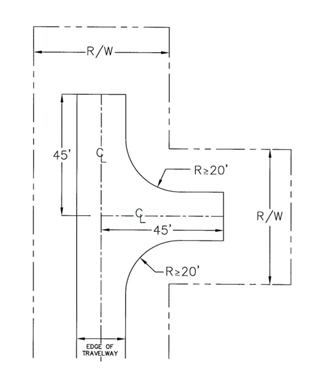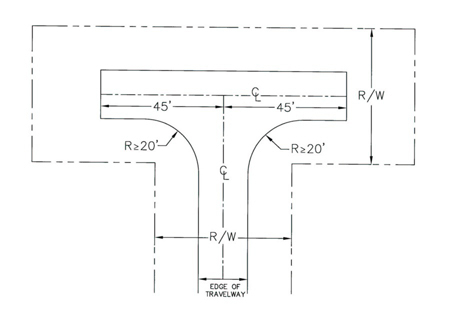42-110. Additional Road Design Standards Applicable to all Road Classifications
- Intersections. Acceptable angles of intersection are:
- 90 to 75 degrees (preferred)
- 75 to 60 degrees (acceptable under extreme conditions as determined by the reviewing agency).
- Adequate Sight Distances. Adequate sight distances (see Figure 3B. Sight Visibility Triangle) along a proposed road shall be provided by:
- Choosing a good location for the right-of-way and clearing sight visibility triangles when constructing the road (the minimum sight distance is 70 feet along the “existing” road right-of-way and ten (10) feet along the “new” road right-of-way).
- Providing an adequate place for vehicles to stop before entering the road.
- Providing an apron design at proposed intersections to permit a vehicle to enter when another vehicle is waiting to turn.
Figure 3B. Sight Visibility Triangle
Not to Scale

- Gates. Entry gates shall be constructed and maintained as required by and in accordance with Chapter 47 of the Henderson County Code, Entry Gates, and SR 3.7 (Gates and/or Guardhouses).
- Dead Ends, Cul-de-sacs and Turnarounds. Vehicle turnaround areas shall be provided at the end of all dead-end roads (excluding private driveway easements) that exceed 300 feet. Loop roads should be encouraged where possible in lieu of cul-de-sac or turnarounds. The reviewing agency may also require installation of turnarounds at:
- Intermediate locations along dead end roads with a centerline length of greater than 2,500 feet.
- The end of a phase of a project.
- An intermediate location along any road that exceeds 1,500 feet in length.
Acceptable alternative turnaround designs for residential subdivisions are shown in Figures 3C, 3D, and 3E. Turnaround areas of a dead-end road cul-de-sac shall have a radius of not less than 35 feet.
Figure 3C. Alternative Turnaround Design - Island
Not to Scale

Figure 3D. Alternative Turnaround Design - Branch Turnaround
Not to Scale

Figure 3E. Alternative Turnaround Design – T Turnaround
Not to Scale

- Bridges. Bridges shall:
- Be engineered to a minimum weight capacity of 50,000 pounds (For purposes of emergency management vehicle access) and documentation shall be provided to indicate such (the 50,000 pound weight capacity requirement shall not apply to driveways);
- Adhere to State Road Standards for drainage, hydraulics and minimum live load;
- Adhere to standards for vertical clearance for roads (See Table 3.3);
- Provide a travelway width not less than the travelway width of the road on either side of the bridge, and in no case less than 12 feet in width;
- Include a paved or gravel turnout on each end of the bridge to provide space for at least one (1) vehicle to safely pull over and allow an oncoming vehicle to traverse the bridge where the travelway width is less than 18 feet and is proposed to accommodate two-way traffic; and
- Provide adequate line-of-sight distances for safe operation of two-way traffic.
